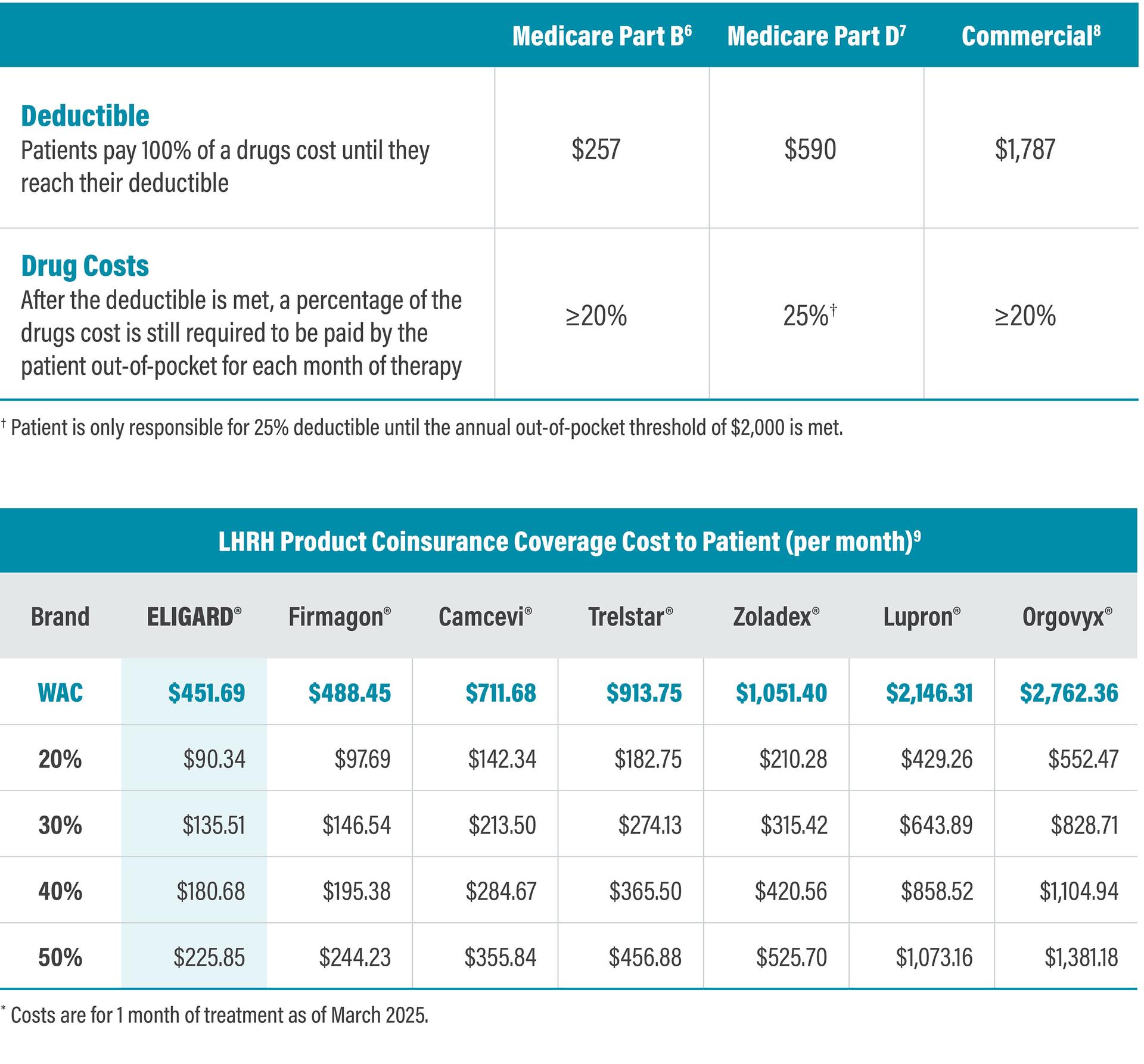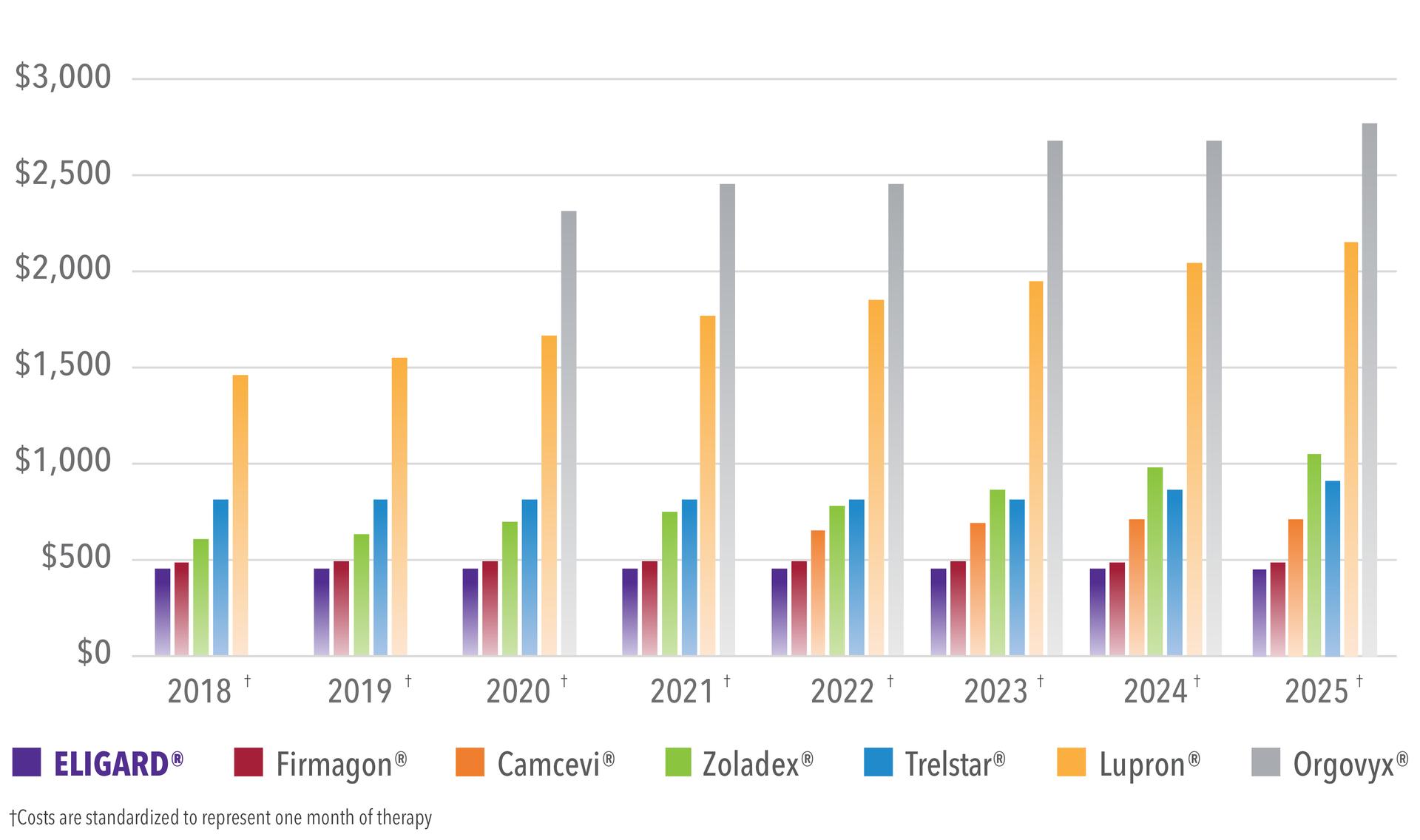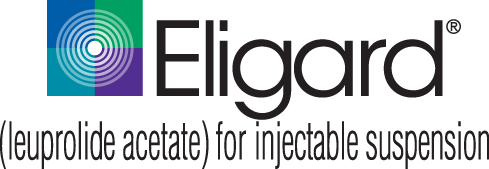© 2024 Tolmar, Inc. All rights reserved. Tolmar, ELIGARD and their associated logos are trademarks of the Tolmar Group. Third-party
trademarks and product names belong to their respective owners. TPI.2023.eng.4010.v3 06/25
Helping patients navigate rising costs for prostate cancer treatment
How drug costs can increase financial burden on patients even with insurance coverage

Cancer is one of the most expensive medical conditions to treat in the US and often leads to financial toxicity that can impact care.
In a study of 281 patients, 54% had some degree of financial hardship due to cancer.1
Of the men with the highest financial toxicity, 89% had illness-related money troubles.1
These men were significantly more likely to decrease spending on basic goods such as food and clothing and more commonly raided their savings to pay for treatment.1

From 2020 to 2024, prices of all items across the Consumer Price Index rose 21.1%, which includes all necessary essentials like food, housing, and medical care.2 This can cause patients to have to choose between treatment and basic living needs.

98 million Americans skipped treatment or cut spending on essentials to cover health care costs.3
Between 38% and 77% of patients with cancer experience debt significantly higher than the general population.4
A significant percentage of cancer patients face financial difficulties, which can in turn lead to material difficulties, psychological distress, and cost-coping strategies to pay for their medical care with potential negative outcomes in their health recovery and overall well-being.5
How drug prices can affect a patient’s out-of-pocket cost
A drug’s price can greatly affect the out-of-pocket cost to a patient therefore it is important to consult with a patient prior to treatment.
Patient Cost Burden by Coverage Type*
If treatment cost is high, perhaps see if a similar, more responsibly priced product is available with similar efficacy and discuss with the provider if that alternative product is available and right for that patient.

Does your office consider cost burden as a side effect of treatment?
Helping to cover co-pay or coinsurance cost
- While there are many charitable organizations that can help with covering copay or coinsurance costs, many have strict income or geography requirements.
- Even if a patient qualifies, funding is always limited and access to these organizations can come and go very quickly.
If a patient gets funding, that funding should be used in the most efficient way to ensure as many patients as possible are covered.
Using a product that is lower in price with similar efficacy can help ensure that those charitable funds stretch as far as possible.
Ways to help patients discuss financial toxicity with your patients:
- Always discuss coverage and cost prior to a patient starting a new therapy or drug
- Follow up with questions like: “Do you have any concerns about paying for your treatment?” “Tell me what you understand about the out-of-pocket costs for your treatment.”
- Refer patients to assistant programs like RxAssist or Medicare Pharmaceutical Assistance Program if they need support
- If you see that a patient’s out-of-pocket cost has increased, follow up with their physician to see if a different product was used. If so, discuss as a care team possibly going back to the original product or if other more affordable options are available
More formal clinical financial assessments have been proposed as part of the American Society of Clinical Oncology’s (ASCO’s) Financial Toxicity Grading Criteria and discussed in ASCO’s booklet Managing the Costs of Cancer Care: Practical Guidance for Patients and Families.
ELIGARD has NOT had a Wholesale Acquisition Cost (WAC) increase in over 10 years9
ELIGARD has consistently had one of the lowest WACs in the LHRH market, ensuring that cost burden to the patient is kept as low as possible.


Tolmar is meeting the needs of patients and providers
Tolmar is committed to keeping ELIGARD responsibly priced to ensure access across healthcare systems, providers, and most importantly – patients
Patient Access Support
Practice Support
Clinical Support
Low OOP Expense
To learn more about ELIGARD’s proven efficacy and flexible dosing visit Eligardhcp.com
IMPORTANT SAFETY INFORMATION
ELIGARD®, (leuprolide acetate) for injectable suspension, is a gonadotropin releasing hormone (GnRH) agonist indicated for the treatment of advanced prostate cancer.
ELIGARD is contraindicated in patients with hypersensitivity to GnRH, GnRH agonists, or any of the components of ELIGARD. Anaphylactic reactions to synthetic GnRH or GnRH agonists have been reported in the literature. Transient increase in serum levels of testosterone during treatment may result in worsening of symptoms or onset of new signs and symptoms during the first few weeks of treatment, including bone pain, neuropathy, hematuria, bladder outlet obstruction, ureteral obstruction, or spinal cord compression. Monitor patients at risk closely and manage as appropriate.
Hyperglycemia and an increased risk of developing diabetes have been reported in men receiving GnRH agonists. Monitor blood glucose level and manage according to current clinical practice. Increased risk of myocardial infarction, sudden cardiac death and stroke has also been reported with use of GnRH agonists in men. Monitor for cardiovascular disease and manage according to current clinical practice. Androgen deprivation therapy may prolong the QT/QTc interval. Consider risks and benefits. May cause fetal harm. Convulsions have been observed in patients taking leuprolide acetate with or without a history of predisposing factors. Manage convulsions according to current clinical practice.
ELIGARD may impair fertility in males of reproductive potential.
The most common injection site adverse events are transient burning and stinging, pain, bruising, and erythema. The most common systemic adverse events include mild to severe hot flashes/sweats, malaise and fatigue, weakness, myalgia, dizziness, clamminess, testicular atrophy, and gynecomastia. As with other GnRH agonists, other adverse reactions,
including decreased bone density and rare cases of pituitary apoplexy have been reported. Please visit EligardHCP.com for full Prescribing and Safety Information
References:
1. Khan HM, et.al. Financial Toxicity in Cancer Care: Implications for Clinical Care and Potential Practice Solutions. J Clin Uro. 2023;41(16) https://doi.org/10.1200/JCO.22.0179
2. Kaiser Family Foundation. 2020 Employer Health Benefits Survey. KFF.org. Published Oct 8, 2020. Accessed May 7, 2025 https:https://www.kff.org/report-section/ehbs-2020-section-9-prescription-drug-benefits/
3. Werble, C. Formularies. Health Affairs Policy Brief. healthaffairs.org. Published Sep 14, 2017. Accessed May 7, 2025 https://www.healthaffairs.org/content/briefs/formularies
4. NIH National Cancer Institute. Financial Toxicity and Cancer Treatment (PDQ)-Health Professional Version. Cancer.gov. Updated May 29, 2024. Accessed Apr 30, 2025 https://www.cancer.gov/about-cancer/managing-care/track-care-costs/financial-toxicity-hp-pdq#_215_toc
5. Banegas MP, Guy GP, de Moor JS, et al. For Working-Age Cancer Survivors, Medical Debt And Bankruptcy Create Financial Hardships. Health Aff (Millwood) 2016;35 (1): 54-61 https://doi.org/10.1377/hlthaff.2015.0830
6. US Railroad Retirement Board. 2025 Medicare Part B Premiums and Deductibles Will Increase. RRB News. rrb.gov. Published Nov 2024. Accessed May 7, 2025 https://www.rrb.gov/sites/default/files/2024-11/NR2410.pdf.
7. Centers for Medicare & Medicaid Services. Final CY 2025 Part D Redesign Program Instructions Fact Sheet. cms.gov. Published Apr 1, 2024. Accessed May 7, 2025 https://www.cms.gov/newsroom/fact-sheets/final-cy-2025-part-d-redesign-program-instructions-fact-sheet/
8. Kaiser Family Foundation. 2024 Employer Health Benefits Survey. kff.org. Published Oct 9, 2024. Accessed May 7, 2025 https://www.kff.org/report-section/ehbs-2024-summary-of-findings/
9. Kaiser Family Foundation. A Current Snapshot of the Medicare Part D Prescription Drug Benefit. kff.org. Published Oct 9, 2024. Accessed May 7, 2025 https://www.kff.org/medicare/issue-brief/a-current-snapshot-of-the-medicare-part-d-prescription-drug-benefit/
10. Data on file, Tolmar, Inc.; 2025


